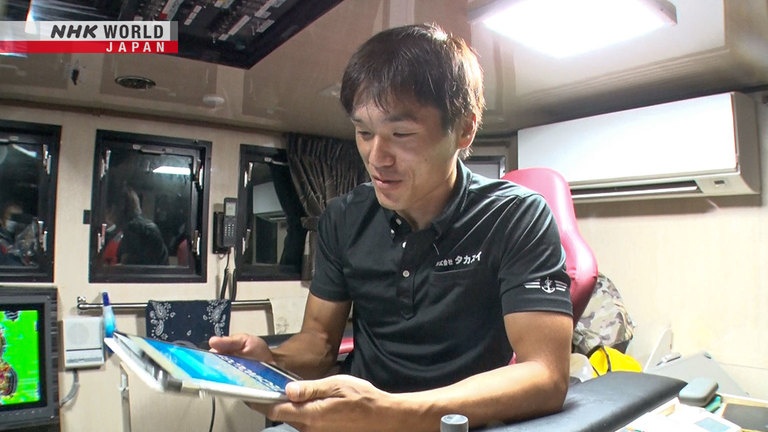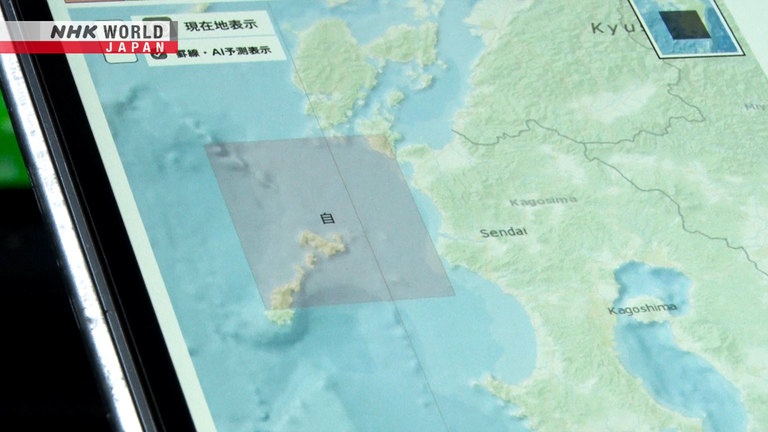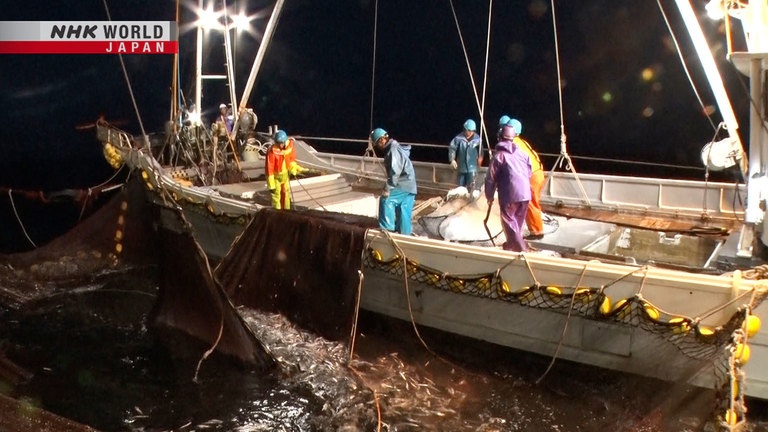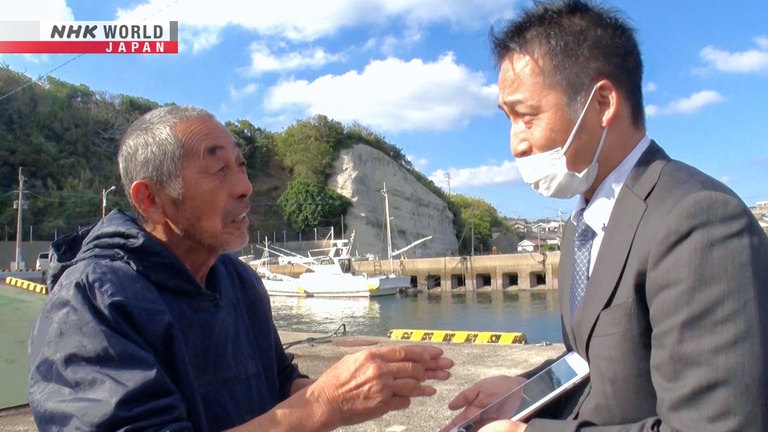Sustainable Fishing through AI: Marine Tech Innovator - Mizukami Yosuke
Though Japan is famed for its fisheries, in recent years, factors such as overfishing and climate change have seen catches fall to just a third of their 1980s peak. Mizukami Yosuke is the operator of a unique app that supports fisheries workers by using AI to analyze the historical movements of veteran fishermen and predict the most fertile fishing grounds. And now, the platform is also being leveraged to collect fisheries data vital to the sustainable future management of fragile fish stocks.




Transcript
"RISING"
"Sustainable fishing through AI"
Marine tech innovator - Mizukami Yosuke
As an island nation, Japan is blessed with fertile fishing grounds.
But factors such as overfishing, pollution, and climate change
have seen annual catches steadily fall
to only a third of their peak in the 1980s.
Catches are down by 90, or even 99%.
There's just no comparison.
And with numerous fish stocks on the decline,
the government has stepped in with a tightening of regulations
to preserve these precious natural resources
and the future of Japanese fishing as a whole.
But some solutions are on the horizon.
We joined one large fleet
that operates off the shores of Kagoshima Prefecture, western Japan.
It's led by 31-year-old fleet captain Takasu Seiki.
In this role, he's responsible for choosing locations
and dictating the timing with which his fleet lowers its nets.
For this, he uses a range of high-tech devices
including tidal current meters and ultrasonic fish finders.
And recently, another tool has assumed a particularly crucial role.
This red square is mapped out by AI.
It uses AI analysis to recommend the best spots to fish.
The app uses historical catch data
to recommend fertile locations with healthy stocks.
Declining fish reserves mean that careful resource management is vital.
The app was developed by a Nagasaki-based firm
specializing in fishing device maintenance and IT-based fisheries solutions.
It's led by Mizukami Yosuke,
who joined the family firm in 2005,
before taking the helm two years ago.
His app was launched three years ago, inspired by a chance encounter.
We joined Mizukami on a trip to Kagoshima.
His destination is the parent company of young fleet captain Takasu Seiki.
Good afternoon!
Today's meeting is about potential improvements to the app.
And also present is Takasu's uncle, Taizo,
who was the initial inspiration behind the app's development.
Now director of the firm, which oversees three independent fishing fleets,
he himself is a former fleet captain.
He first met Mizukami in 2016 at a seminar for young executives.
There were three of us, the main fleet captains,
but we were all getting older.
We knew we'd have to pass on the torch,
but we were worried about declining catches.
So, at the very least,
we wanted to try and pass on the know-how we'd built up.
I used to write a log every day by hand.
Here are some examples of those handwritten captain's logs.
So that's October 29, 2000, 2001, 2002.
Yeah. You can easily see entries for the same day in different years.
That's why I chose this style.
From 2000 to 2020, he kept these records every day without fail.
The details he recorded included the port,
fishing ground, types and quantities of fish caught,
and even the sea temperature.
In terms of paper logbooks, this is pretty user-friendly,
but I thought we could take that further with a tablet or something,
with everything shown on a map to be grasped at a glance.
But after years without making that a reality, I met Mizukami-san.
And I said, "We could make that. No problem."
Yes, you did say that, didn't you?
I mean, this is an age where people can go to space,
so there's no reason why we couldn't do this.
And as we went on, he suggested incorporating AI,
and I thought that sounded fascinating.
The idea was to transfer the know-how of veteran fishers to the AI system,
so that even when those veterans weren't able to go out to sea,
the AI could carry on working in their place.
We thought that would be strong support for the younger workers
and that's why we decided to work with AI.
The following year, Mizukami launched a new business venture,
working with a third-party AI specialist to develop the app.
The aim was to provide an accurate understanding of marine resources.
They set out using Takasu's logbooks to train the AI
in how the fleet captain had selected fishing locations down the years.
And after a year of development, the app was ready to trial.
In February 2019, a preliminary version of the app
was presented for the first time to Takasu Taizo,
to see if it matched his expectations.
That would have been my own first or second choice today.
Really? Great!
The AI system successfully pinpointed one of the locations
Takasu had been considering that day.
It's a big relief.
I was pretty worried.
This AI can support what we do.
It's like having a capable new tool, or a new colleague.
Takasu's fleet agreed to trial the app
and help refine it through real-world usage data.
And during that process, Taizo himself retired from active seafaring,
while his nephew Seiki came through the ranks
to take the helm of his own fleet.
When I'm not sure where to go, west or east or north or south,
say I'm wavering between two of those, I'll open up the app.
And if it suggests east, then we'll give that a try.
It helps me choose our fishing ground.
This young captain is supported by a virtual database
of his veteran uncle's know-how.
Satellite data on factors such as ocean temperature
is analyzed through the prism of historical fishing records,
to predict the most fertile fishing grounds on any given day.
Takasu steers the fleet in the direction suggested by the app.
For a five-vessel fleet like this,
a single trip out to sea can incur operating costs of over a million yen,
which means it's especially crucial that they don't return to port empty-handed.
Having located a school,
the lead research vessel lights a flare to attract more fish.
And the deckhands roll into action.
Takasu instructs them to lower the nets
in order to scoop the fish attracted by the blazing bright flare.
Tonight, it's herring.
And the AI has guided them to the most viable spot.
With marine resources on the decline,
accuracy is a paramount concern.
And as fishing moves into a new era,
AI systems constitute a crucial aid to fisheries management.
These tools are a big help to our captains.
When you're placed in charge like that, you have all sorts of worries,
and as captain it's your personal responsibility
to ensure a good catch.
So if AI can provide that information, that support and guidance,
then it really eases your mind.
And to further prevent overfishing,
the aim is to enhance the app with analysis of market patterns and prices,
to estimate ideal catch sizes.
To preserve the lifestyles of fisheries workers into the future,
ultimately, sustainability is absolutely crucial.
We can use data to analyze shifts in price
and limit catch sizes in response to demand.
I think that will help maintain profits
and aid the recovery of marine resources.
Mizukami's company is based in Sasebo, Nagasaki Prefecture.
We join him on a trip to a nearby island,
where he's trying to promote the use of his app
to the many independent local fishers.
Ninety minutes from Sasebo by sea bus is the island of Ojikajima.
Long famed for its fertile coastlines,
fishing is the main local industry.
(Sea bream)
But here too, catches have been on the decline.
(Grunt)
(Blacktip grouper)
Mizukami visits the local fishing association.
Good afternoon.
Today's meeting was arranged after the group agreed to trial his app.
At present, the national government is promoting "smart fishing."
But we have to ensure that brings benefits to fisheries workers, too.
And we are working to ensure that the data collected by the system
can be used in the kinds of resource evaluation and management
that the government is advocating.
The association's decision to trial the app was actually prompted
by a major change at the national policy level.
In 2020, the rollout began of new regulations under Japan's Fisheries Act.
It was amended to focus more closely on marine resource management
with the ultimate aim of replenishing depleted fish stocks
to ensure sustainable catches and preserve the marine environment.
But such management requires accurate data collection.
As such, the reporting rules applied to large fleets
were also extended to independent fishers.
While the number of species subject to reporting
is being expanded from 8 to 200,
and these new regulations will also place extra strain
on small fishing outfits.
What kind of management approaches are already in use in Ojikajima?
Net-caught grunt.
That's 14.4 kilos.
Individual boats' catches are weighed by species,
and the results transcribed onto special record slips.
These handwritten slips are used to monitor catch size and type
for all 318 local fisheries association members.
And the increase in specified species from 8 to 200
will massively raise the administrative burden.
But streamlining this process could compromise accuracy,
which is where Mizukami's app comes in.
And the fishing association has high hopes for this new tool.
The plan is eventually to report all fish varieties.
That'll mean extra work, not just for the fishers,
but for administrative staff at the association too.
So, if we can automate that process, digitize it all,
then that will ease the burden on fishers and staff.
The app is synced with the association's own system
for instant sharing of operational data from fishing trips.
And this can be easily reported to the national authorities
with minimal extra work.
And besides fish species and catch size,
the app also records location, fishing technique,
and a host of other oceanographic data,
for even more precise and sustainable resource management.
As such, the fishing association is keen to promote widespread uptake
among local fisheries workers.
We dropped in on one promotional seminar.
As the government's fisheries management plans proceed,
they have to be able to leverage data and science
to protect the livelihoods of fisheries workers.
An important aspect of that
is for workers to electronically record their fishing logs.
That is essential to the management required to replenish fish stocks.
And in the long term, we can replenish those resources
while growing your income.
The aim behind our development
is to digitize your long reserves of experience
in a way that will bring further benefits for fisheries workers.
But rather than a source of benefits,
some of these veterans see digital record keeping as a source of extra work.
Ah, I can't do it.
It may be great for the next generation, but...
we're all more analog.
It's an issue, but I think we're all like that.
All Greek to me.
I can't master modern stuff like that.
I always ask myself if I'm doing the right thing,
trying to explain the importance of data to these fishermen.
And I do wonder if it's a futile task.
But I suppose these are just the kind of things that
we do need to think carefully about.
Almost all of Ojikajima's fishers are solo operators.
And Mizukami has managed to secure the participation
of one younger individual in trials of his app.
Yoneda Hayato has been fishing for almost a year.
I felt that taking a lasting record of how and where my catches came
might be useful in the future.
5 PM, and he heads out to sea in search of squid.
The first step is to record the time and the location he sets out from.
An hour later, he arrives at the evening's fishing ground,
and turns on his fishing light to attract a catch,
before also recording this location via the app.
He has a selection of squid lures,
which are strung together
and hung from the port and starboard sides of his boat.
He sets eight lines in all.
(Swordtip squid)
And each one must be continually checked,
and any catches quickly transferred to a tank in the hold.
It's a process that goes on all night without rest.
Another vital task is exchanging lures on the fly
to suit fishing conditions.
And this level of hard work is characteristic of squid fishing.
It is quite tiring.
To prevent the squid eating each other, he transfers them to a cooler box.
And with no time to take a break,
he even eats on his feet while carrying on with his duties.
At 2 AM, some six hours after casting his lines,
he wraps things up for the night.
Stopped work...
And he immediately logs this too.
I'll log the catch weight later.
But sometimes he's so tired that he forgets to log the end time.
The next thing to log is his return to port.
Today's entire journey was recorded.
The course between laying his lines and drawing them
in is shown by this red line.
And the process continues back on dry land.
Oh, my back...
He records the volume of catch, fishing method,
water temperature, and tidal direction.
It's taxing work after a tiring night's fishing,
which is another barrier to older workers' participation.
So, in response, Mizukami is trialing another improvement to the app,
automated data input.
A lot of fishers do forget to push start and stop.
I suppose it is a lot to handle on your own.
Some people forget, and others just insist they can't do it.
So instead of having them do all that,
we need to actually get on board with them one by one,
to see what features the app needs.
We need to build up a database to improve accuracy by training the AI.
Development gets underway on an automated version of the app.
And Mizukami's team head out with fishing crews to collect data.
One volunteer is 62-year-old Toyama Masuo.
They begin by adding a GPS tracker to his boat.
This is an IoT device that will enable AI
to establish where he did his fishing.
The tracker is powered directly from the boat's own power supply,
meaning it turns on automatically when the engine is engaged.
Thanks for your help.
This shows today's tide.
This black dot shows our current position.
- And this tracks my journey?
- Right.
From now on it will be constantly recording.
Can I see that?
Yes, when you get back in, we'll have all your movements visualized.
All you have to do is turn the engine on, and set out as normal.
And that's about it!
Got it.
Thanks again.
With the engine engaged, the automatic recording commences.
This new approach eliminates the risk of forgetful operators.
Today's fishing ground is about ten minutes down-shore from the port.
Toyama's approach is longline fishing, which, as the name suggests,
uses a single long line with baited hooks.
A member of Mizukami's team is on hand
to log the start and end of this session.
I logged the time he lowered the line, which helps build up data
to teach the AI how long he was actually fishing for.
And eventually, that'll show us the quirks of individual fishers.
In the long run, the aim is to automatically record everything,
from fishing location to water conditions and more.
Today, Toyama returns early without catching anything.
And that marks the end of the day's trial.
- All done.
- Good job.
Your whole course from departure to return has been successfully captured.
And it lets you look back on what the sea was like
in the location you started fishing and so on.
It would be even better if it could show you
the longitude and latitude with one touch.
Ah, I see.
That'd be more useful than the course.
Ah, thank you.
You know, it's no use like this.
Ha ha ha! We'll do what we can.
Even damning feedback like this
is necessary to help us refine our software.
So it's very welcome input.
That's how I see it.
And though Toyama was critical, he, too, has high hopes for the system.
If you could check it onboard at any time,
then that would help predict the day's schedule before you got there.
It would save on fuel.
And it would cut down the time you needed each day.
That would make work easier.
The day arrives to sign contracts for the new automated version of the app.
Seven local fishermen have come to sign up,
including Toyama Masuo, who took part in the trial.
These are the contracts for the app, which we'd like you to fill in.
Be sure to write down your own easy-to-remember passwords.
Two-thirds of the subscription fee will be covered by state subsidies.
And once the contracts are signed,
they get down to setting up participants' devices.
At my age, I didn't think I needed it.
But the youngsters said I should sign up.
If we don't place our trust in machines,
our catches won't improve.
Of course, I'm a little nervous,
but we'll all just have to work things out among ourselves.
These apps are both a support tool for fisheries workers
and a platform for gathering data vital to marine resource management.
And Mizukami Yosuke will continue working toward these goals
alongside fishing professionals.
As well as supporting the current lifestyles of fisheries workers,
I see our role as preserving their future
by making those lifestyles more sustainable.
If we were just to give up on sustainable fisheries management in Japan,
then I think that really would be the end.
So instead of just saying we can't do something, we have to find a way.
And like that, I think we can achieve
a new style of fisheries management that wasn't possible before.